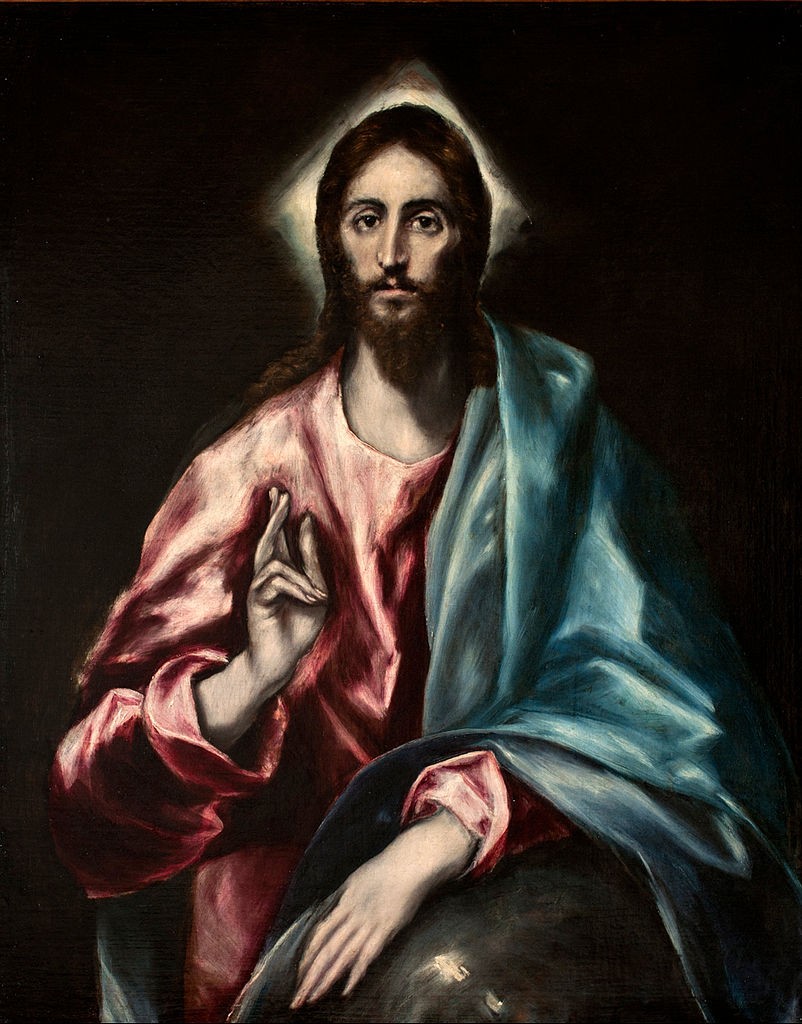2002 North Main Street
Santa Ana, California 92706
TEL: 714.567.3600
El Greco's "The Savior" and Cochineal Red
 |
| El Greco, The Savior (from the Apostles series), Toledo, Spain, ca. 1608–1614. Oil on canvas, 39 17⁄32 x 31 37⁄64 in. Museo del Greco, Toledo, IPCEGRE-GS1(CE00001). Photo: Tomas Antelo, Instituto del Patrimonio Cultural de España, Madrid. |
El Greco is one of Spain’s most famous painters. In his lifetime he challenged Spanish painting norms, created a new interpretation of classical beauty, and laid the groundwork for artists like Picasso and his Cubism almost 400 years later.
As his name suggests, El Greco was not a native Spaniard. Born Domenikos Theotokopoulos on the isle of Crete in 1541, El Greco started out as an apprentice studying Byzantine painting. The art tends to rely on gilding and glazes—dyes like cochineal— rather than perspectival depth; something which El Greco challenged from an early age by introducing elements of the third dimension into what would otherwise have been very traditional Byzantine works.
Around 1567, El Greco left Crete for Italy where he drew heavily from the methods of Titian and Tintoretto. It was through these men that he learned how to elongate body proportions and how to use light and color to bring life to his flame-like figures. El Greco’s unique interpretation of the Mannerist style has puzzled art historians almost since his own time, being entirely unique and anachronistic yet also ahead of its time.
In 1577, already a master of his craft, El Greco left for Spain seeking an appointment at the court of King Philip II. Unfortunately, for one of a number of possible reasons, the King did not take a liking to El Greco’s paintings, and the Cretan painter had to find commissions elsewhere. Whatever reservations the King had concerning El Greco’s art were not shared by many, though.When El Greco settled in Toledo, the seat of the Archbishops of Spain, he was kept busy by an incredible volume of requests for religious works. He lived out the rest of his life in Toledo, where he became a part of the town’s intellectual elite and lived to see his painting style become considered an art form rather than as craft. His most famous works, such as The Burial of Count Orgaz (1586-88), were designed to make this clear. El Greco’s outstanding tenebrism, brilliant use of color, classical composition and beautifully elongated figures remind the viewer that, along with the classical harmony of the scene depicted, the viewer’s visceral reaction to the painting is reinforced by the unprecedented technique with which El Greco paints it. Unfortunately for El Greco, though, the Counter-Reformation emphasized the purity of religious doctrine above the Renaissance’s concern with the beauty of the human figure. This made it an awkward time for a humanist like El Greco to gain the attention of Spanish patrons, who were becoming ever-more religiously orthodox. But the Counter-Reformation also assured him a steady stream of religious commissions, something that the pathos of his figures helped sell: paintings of martyrs on the cross to reminded Spanish Catholics that, faced by the threat of the Protestant Reformation, their religion was worth fighting for.
The El Greco painting at the Bowers Museum is currently on loan as part of the exhibition The Red that Colored the World, and fits well within this category. It was made between 1608 and 1614, the year El Greco died, as part of a series of twelve portraits of the apostles, each of which faced a central portrait of The Savior. Similar to the rest of El Greco’s works, we see that Christ has elongated features and there is extreme contrast between Christ’s pale colors and the pitch-black background. Interestingly, a heavy Byzantine inspired halo hovers behind and illuminates Christ’s head, showing that El Greco never forgot his eastern roots even in the final years of his life. The most important feature of the painting, or at least the reason for its transatlantic journey, is Christ’s brilliant red and blue tunic, in which the red represents Christ’s passion, and the blue his reason. The red dye on Christ’s tunic is a cochineal glaze, something El Greco used for decades. He realized its qualities as the best dye for breathing realism into a painting’s textiles, allowing the central figure of this painting to be seen in three-dimensional depth unimaginable by a Byzantine-trained painter.
This exhibition was organized by the Museum of International Folk Art, Santa Fe, New Mexico, USA, and made possible by the generous support of the National Endowment for the Humanities and circulating through GuestCurator Traveling Exhibitions. The exhibition was generously supported by Orange County Fine Art Storage.
Text and images may be under copyright. For permission to use please contact the Collection Department. Information subject to change upon further research.
Text and images may be under copyright. For permission to use please contact the Collection Department. Information subject to change upon further research.


Comments 1
Christ is arisen!
Perfect through earthly ruth,
Radiant with love and truth,
He to eternal youth
Soars from earth’s prison.
Christ is ascended !
Bliss hath invested Him, —
Woes that molested Him,
Trials that tested Him,
Gloriously ended.